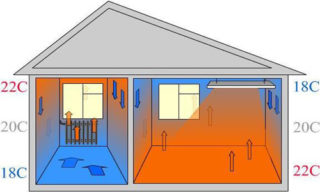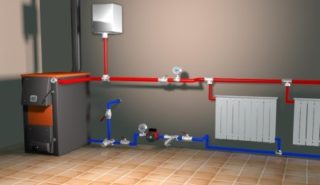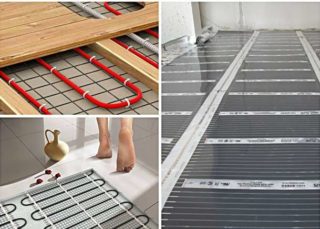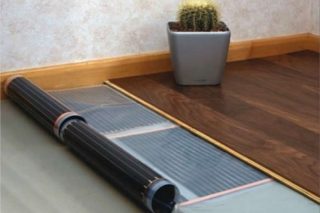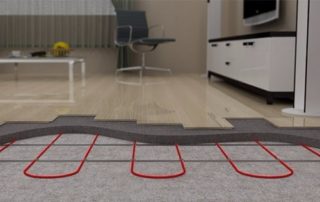During the construction of a new building, many issues need to be addressed. When the box is removed, the roof is covered, windows are inserted and rough finishing works are carried out, it's time to think about heating. Here you need to decide - it is more profitable underfloor heating or batteries in a private house of a particular layout. Both that and another can work effectively provided that all incoming conditions are carefully calculated.
Subspecies of systems
To better understand the functioning of systems, you need to know their varieties.
Water heating on radiators according to the principle of operation:
- Designs with gravity flow of the heat carrier. They are single-tube execution and assembled according to the principle of two lines.
- Thermal circuits where liquid is pumped by circulating pumps. The wiring in such boiler rooms can be implemented on one pipe, be two-channel, two-pipe associated type and beam.
You can encounter only two options for a heated floor: with a liquid and an electric principle of action.
Battery heating
This type of home heating can be called classic. The standard system has the following main elements:
- Boiler. It can work on any type of fuel, including electricity. The main task is to heat the coolant to the required operating level. Also, the electronics is assembled in the boiler for automatic operation in a given mode.
- Radiators Devices through which direct heat transfer from hot water or antifreeze to the environment occurs. Convectors come in various designs with ribs for greater contact with air. They are made from materials that conduct heat well (various metals). Depending on the size of the product, its recoil power changes.
- Heat pipes. The task of these components of the structure is in the communication of the boiler and radiators, along which the liquid continuously moves. Water conduits can be made of special plastic of various kinds, be metal or composite. These products are produced in different capacities.
- An expansion tank with a protection group is needed to prevent the destruction of boiler equipment during water overheating.
- Various fittings and valves. Elements are used to organize the connection of individual components of the circuit, as well as adjust the system.
The operation of heating is very simple. The boiler heats the water, it moves through the pipes to the batteries under the action of the pump, they heat up and transfer heat to the room. The cooled liquid is returned back to the boiler.
Radiators are usually installed along the exterior walls of a building under windows.
Underfloor heating
The fundamental difference between the heated water floor and convectors is that it is laid under the entire plane of the floor covering. Due to the large coverage area, the temperature level of the coolant in the pipe is much less than in the classic version with outboard heaters. Otherwise, the way they act is similar: the boiler warms up the liquid, it moves through the supply pipes and enters the heat circuit embedded in the thickness of the concrete screed.
The liquid heated floor contains in its structure one important element - the adjustment group, without which its normal functioning is impossible.The essence of its task is to balance the operation of individual thermal circuits embedded in different rooms.
A variant of the floor on electricity is laid in the same way as water, but for its functioning there is absolutely no need for a boiler. The heater itself is a high-resistance cord that generates heat when connected to a standard voltage network.
The main advantages of radiators
Installation of heating batteries is less time-consuming in relation to the arrangement of a warm floor, and this is the main advantage of this type of equipment. If the design refers to gravity, fan cut-offs of energy or breakdowns on the line in no way affect the efficiency of convectors, it will be comfortable in the house.
The control of the boiler room elements is more flexible, since you can put your own thermal head on each individual heater.
Which system is more economical
Turning to the issue of profitability, we can cite as an example the statistical data of the analysis of the operation of thermal circuits obtained in practice. Heated floors work up to 50-30% more efficiently.
- The surface, heated from below, contributes to a more even distribution of the heat flux. The heating height is just in the zone that is comfortable for human life - within 2-2.2 meters.
- The floor heating system refers to low temperature. The heating of its line does not exceed the rate of 45 degrees Celsius. If you take radiators, they begin to radiate heat efficiently at a surface temperature of the metal equal to 70 degrees Celsius.
- The inertia of heated concrete is much higher than the inertia of even heat-intensive cast-iron batteries, so it will keep the temperature in the living room longer.
Hanging liquid heaters during operation can reach temperatures of 70 degrees Celsius, which is dangerous for small children with the risk of burns when touched.
Which system is easier to repair
Considering the maintainability of boiler equipment, you need to understand which elements in it are most at risk of failure. If we take into account only the batteries themselves and the pipes of the heated floor, hidden in the thickness of concrete, it is much easier to remove the convector from the wall and simply replace it than to disassemble the screed. In the latter case, you still need to understand where to look for damage.
A professionally made floor may not cause any problems at all, because the water conduit itself practically does not wear out and does not corrode, which can not be said about batteries, especially made of steel. The reliability and maintainability of the other parts of the heating in both structures depends only on the quality of the equipment, components and operating conditions.
It is important to pay special attention to the coolant that will be used in the operation of the heat circuit. The more aggressive, stiffer, and richer the salts, the faster it will damage different parts of the structure. In this case, it is recommended to use good filters.
In which case the heat in the room is felt faster
If we take the average indicators of the speed of heating a building with heating radiators or underfloor heating, the former are approximately three times faster. The inertia of the second is due to the need to warm the entire thickness of the concrete screed. Turning to the numerical expression, to feel the heat in the apartment with aluminum heaters, you need to wait about 20 minutes. The same volume of the room, equipped with a heated base, will gain a comfortable temperature in a couple of hours.
As for the response to adjustment, the situation repeats itself here - convectors, due to low inertia, heat up and cool down very quickly, which immediately affects the air temperature of the housing.
Having analyzed all the pros and cons listed, you need to remember one more thing - the aesthetic component of the issue. Sometimes the interior design is designed in such a way that it is simply impossible to organically fit heating elements installed on the walls into it. In this case, the only solution is to lay a heating pipe under the floor, although the most sophisticated plumbing equipment is on sale.
